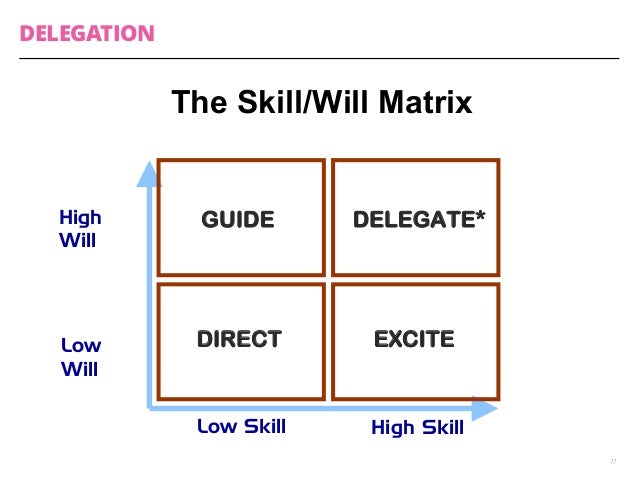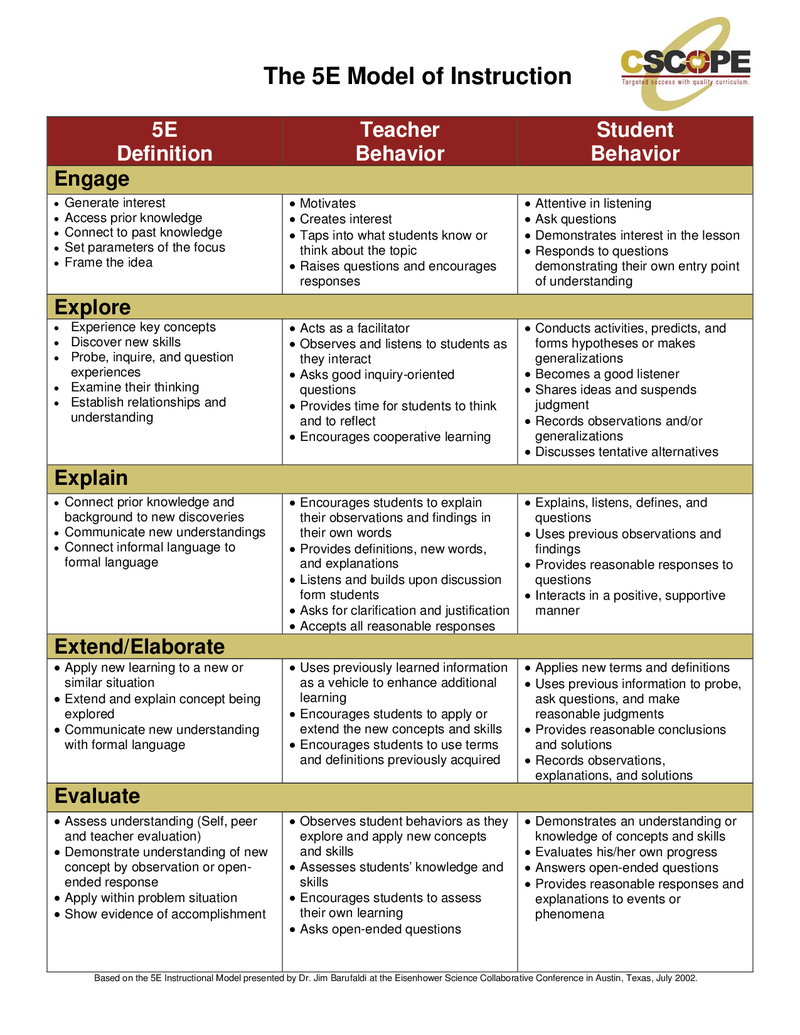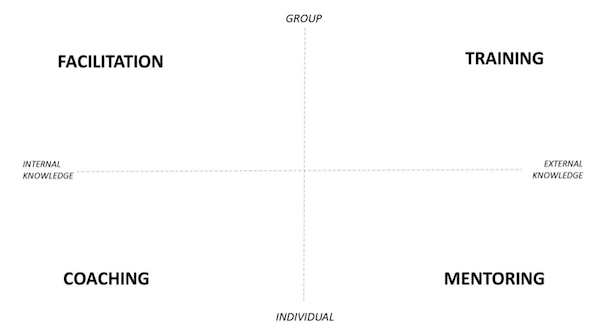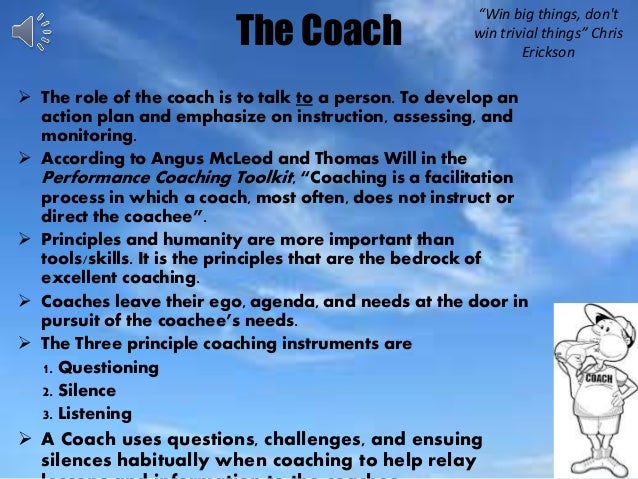Direct instruction modeling coaching and facilitation
Direct instruction modeling coaching and facilitation
Direct Instruction and related methods that focus on basic skills demand more attention. It is possible for children to learn much more than the “child-centered” and “developmentally appropriate” experts would have us believe. Many schools have experienced the power of Direct Instruction …
28/04/2014 · DIRECT coaching model
Direct instruction is effective because it is based on behavioralistic learning principles (obtaining students´ attention, reinforcing correct responses, providing correc-tive feedback, and practicing correct responses), increas-ing the academic learning time during which students are attending to the task at a high success rate. Students learn basic skills more rapidly when they receive a
In the Direct Instruction models, the teacher imparts knowledge or demonstrates a skill. In the Indirect Instruction models, the teacher sets up strategies, but does not teach directly; the students make meaning for themselves. In the Interactive Instruction models, the students
• Establish the level of independence and plan for determining amount and level of supervision (direct or indirect). Consider your role as a preceptor and when to apply which role for each level of learner (i.e. direct instruction, modeling, coaching or facilitation (see Table 1) throughout the placement.
Facilitative teaching seeks to help [learners] “construct” meaning and come to an understanding of important ideas and processes. Teachers in this role guide [learner] inquiries into complex problems, texts, cases, projects, or situations. Their principal methods are questioning, probing, and process-related commentary, with little or no
Simulations are another engaging way to help students better understand lessons. Consider permitting them to participate in immersive experiences, like creating a model legislature or classroom government. And for your visual learners, consider multimedia presentations which can …
Facilitation Approaches Standards Skills Strategies

(PDF) A Constructivist Model of Mentoring Coaching and
Teachers and professors act as the sole supplier of knowledge, and under the direct instruction model, teachers often utilize systematic, scripted lesson plans. Direct instruction programs include exactly what the teacher should say, and activities that students should complete, for every minute of the lesson.
Part 1: Facilitation Theory and Feedback Models What are the traits and practices of an effective facilitator, and how can effective facilitation benefit a project and team? Topics: Facilitation, public speaking, content neutrality, active listening, asking the right questions, staying on track, feedback/coaching . Summary:
Students need the teacher directed methods and the repetition, modeling, and monitoring that are the core of direct instruction. *This is my fourth year teaching in a Direct Instruction school. In my 25 years as a teacher, this is the best form of instruction our children have received.
06/10/2019 · Teaching models are methods of teaching or underlying philosophies that guide teaching methods. Effective teachers will integrate different teaching models and methods depending on the students that they are teaching and the needs and learning styles of those students. One model of teaching is referred to as direct instruction. In direct
models. Among the interventions categorized as having the “strongest evidence of eff ectiveness” (Direct Instruction, School Development Program, and Success for All), Direct Instruction was found to have the largest average eff ect size (0.21) and to be grounded in the greatest number of …
Facilitation Approaches [Adapted from: Bloom (2005). Blended Coaching, Skills and Strategies to Support Principal Development, Corwin Press] Instructional. An instructional approach is a more pedagogical approach. The facilitator usually possesses experience, expertise and wisdom in a particular area. A facilitator might give direct feedback
Basic Philosophy of Direct Instruction (DI) Print Email Siegfried Engelmann What is DI? Direct Instruction (DI) is a model for teaching that emphasizes well-developed and carefully planned lessons designed around small learning increments and clearly defined and prescribed teaching tasks.

Facilitation is a set of skills to be used in working with a group, enabling and supporting them to achieve their objectives in a way that involves and respects all contributions, builds ownership and releases the potential of the group and its members. It helps differentiate between process and content.
Coaching in Early Intervention – Introductory Presentation. This presentation was developed by coaching leaders in the Valley region of Virginia and is now available for others to use with EI practitioners. It was designed to provide an introductory level training (4 hours) to EI practitioners about coaching practices. Special thanks to the
form of guided discovery where the teacher avoids most direct instruction and attempts to lead the student through questions and activities to discover, discuss, appreciate and verbalize the new knowledge. History Constructivist teaching methods are based on …
Put simply, coaching is a process that aims to improve performance and focuses on the ‘here and now’ rather than on the distant past or future. While there are many different models of coaching, here we are not considering the ‘coach as expert’ but, instead, the coach as a facilitator of learning.
Hi Barbara, thanks for sharing such clear difference and I do agree with most of them. i just want to say it is well written, thank you. I have started to be more aware and doing process facilitation and feel that a great difference is about creating shared outcome from within the team or organization which is such a powerful space for the people.
When to Use Direct Instruction. Direct instruction is best-suited for teaching small chunks of information. This might be a spelling rule, such as the -tch or -ch as an ending sound, a short math
01/12/2014 · What is the difference: Coaching VS Training. Learn Coaching Mentoring & Counselling by Mr Vivek Bindra Best Corporate Leadership Trainer in India – Duration: 7:15. Dr.
Australian Journal of Teacher Education Vol 43, 7, July 2018 110 . Teachers Taking Up Explicit Instruction: The Impact of a Professional Development Model Including Directive Instructional Coaching
The number and type of questions the resident asks when you are in the modeling role may indicate if he/she needs more direct instruction or is ready for coaching. If you have to give lots of correction or direction in the coaching role you may need to model again. On the other hand, if …
DIRECT INSTRUCTION. Direct Instruction is a Model Too; #EDCAMP PE. #EdCamp PE – A New Model of Instruction Where Students Lead the Way HEALTH BASED PHYSICAL EDUCATION. Health-Related Fitness Models in Physical Education Toward the Development of a Pedagogical Model for Health-Based Physical Education; INQUIRY BASED LEARNING. 3 Ways to Learn More about Inquiry-Based Learning …

In-Class Coaching Print Email In-class coaching helps prepare teachers to become master Direct Instruction (DI) teachers. It is intended to improve teachers’ mastery of DI techniques at the same time that it builds teachers’ confidence in their abilities to effect positive changes in student performance.
On a side note, I’m not dismissing the value or importance of direct instruction; it plays a necessary role in the classroom. Just ask yourself this: Is there a balance between these three types of teaching in my instruction: direct, facilitation, and coaching? (See Wiggins’ and McTighes’ Understanding by Design for more on these types of
Coaching and mentoring use the same skills and approach but coaching is short term task-based and mentoring is a longer term relationship.. The CIPD differentiates between coaching, mentoring and counselling. It is helpful to understand these differences as, although many of the processes are similar, they are generally delivered by individuals with different qualifications and different
Introduction to facilitation Facilitate means ‘to make easy’. Facilitation is the glue that holds a group together. The role is to work with a group of farmers who are in much the same situation, to draw-out knowledge and ideas from different members of a group, and to help them learn from each other and to think and act together. Facilitation
What is the Difference between an Instructor and a Facilitator? By Bill Wilder, Director of the Life Cycle Institute and Tara Denton Holwegner, CPLP Learning experiences produce results by changing behavior. Behavior-changing learning experiences are led by experienced, passionate professionals who know the content and how people learn.
Effective Coaching: Improving Teacher Practice and Outcomes for All Learners PURPOSE OF THE BRIEF The purpose of this brief is to synthesize research on coaching 1 and to offer a framework of effective coach-ing practices. • Part 1 provides general information on coaching, including the need for coaching and the goals of coaching. • Part 2 describes critical coaching practices that are
Part 1: Facilitation Theory and Feedback Models What are the traits and practices of an effective facilitator, and how can effective facilitation benefit a project and team? Topics: Facilitation, public speaking, content neutrality, active listening, asking the right questions, staying on track, feedback/coaching
“Aren’t facilitation, coaching and training the same?” When interacting with clients, this is one of the most common questions I’ve received. And I love it, because it allows me to dig deeper and describe the distinct values each of those professions brings to an individual and an organisation.
Guided instruction. A learning approach in which the educator uses strategically placed prompts, cues, questions, direct explanations, and modeling to guide student thinking and facilitate an increased responsibility for the completion of a task (Fisher & Frey, 2010). Problem-based learning
Managers often use the terms “training” and “coaching” interchangeably. This leads to a lot of confusion for both managers and employees, and makes it difficult to evaluate the outcomes of
Coaching in Early Intervention veipd.org
Those coaching teachers need to practice the same questioning processes. Explore a questioning protocol that you can use to guide your work facilitating learning. The model examines questions for gathering information, working with information and taking action. Consider the complexity of questions rather than higher and lower order.
9. Model the concept/skills as many times needed to make sure all students are ready to do it on their own. 10. Allow many opportunities for students to ask questions and get clarification. The time it takes to model a concept or skill is dependent on the size of the task students are being required to do. Modeling some skills may take just a
How to Know When to Facilitate, Train or Coach As a consultant, you might provide a variety of types of consulting, such as management consulting or technical/specialized consulting. In addition, you might perform a variety of other roles, primarily the roles of facilitator, coach, expert or trainer. This is true whether you are an external or
ownership of the goal, the coach has primary ownership of the process. In most cases, coaching involves direct extrinsic feedback (i.e. the coach reports to the coachee what he or she has observed).’ Meggison and Clutterbuck, Techniques for Coaching and Mentoring . Context . Students are unlikely to study or be examined on mentoring and coaching.
Direct Instruction professional development extends beyond the learning portal and initial implementation. From virtual Direct Instruction conferences to Live Hangouts and on-demand YouTube Webinars, there are all kinds of ways to refresh your curriculum knowledge. – volleyball coachs survival guide Facilitating and coaching teams are learned skills that require education, observation, and hands-on experience. The authors have used facilitation and coaching techniques with over a thousand teams to get them back on track and performing at maximum potential. This article includes tips
A Constructivist Model of Mentoring, Coaching, and Facilitating Online Discussions Article (PDF Available) in Distance Education 26(3):341-366 · November 2005 with 466 Reads How we measure ‘reads’
Facilitation Skills: Developing Facilitative Leadership Groups that need to make decisions or engage in a planning process often find that using a trained facilitator makes this process more efficient and easier for everyone involved. A good facilitator can keep meetings focused on the subject of discussion or on dealing with the problem
What we mean by Facilitation ICAUK
Effective Coaching Improving Teacher Practice and

Australian Journal of Teacher Education
Facilitating and Coaching Teams Tips and Techniques

Instructional Models in Physical Education
Coaching Direct instruction


DIRECT Coaching Model YouTube
Part 1 Facilitation Theory and Feedback Models
– Facilitative Teaching Facilitation and Process Design
Coaching VS Training YouTube


Teaching vs. facilitation fao.org
Facilitating and Encouraging Learning A Teaching Guide
20 thoughts on “Direct instruction modeling coaching and facilitation”
Effective Coaching: Improving Teacher Practice and Outcomes for All Learners PURPOSE OF THE BRIEF The purpose of this brief is to synthesize research on coaching 1 and to offer a framework of effective coach-ing practices. • Part 1 provides general information on coaching, including the need for coaching and the goals of coaching. • Part 2 describes critical coaching practices that are
Coaching Direct instruction
Coaching facilitation and training the differences
Introduction to facilitation Facilitate means ‘to make easy’. Facilitation is the glue that holds a group together. The role is to work with a group of farmers who are in much the same situation, to draw-out knowledge and ideas from different members of a group, and to help them learn from each other and to think and act together. Facilitation
Tools for Teaching How to Transform Direct Instruction
• Establish the level of independence and plan for determining amount and level of supervision (direct or indirect). Consider your role as a preceptor and when to apply which role for each level of learner (i.e. direct instruction, modeling, coaching or facilitation (see Table 1) throughout the placement.
Know the difference between ‘training’ and ‘coaching
NDIRECT NSTRUCTION IN EACHING NGINEERING Teaching
Facilitation Skills: Developing Facilitative Leadership Groups that need to make decisions or engage in a planning process often find that using a trained facilitator makes this process more efficient and easier for everyone involved. A good facilitator can keep meetings focused on the subject of discussion or on dealing with the problem
5 Big Differences Between Training and Facilitation
How to Know When to Facilitate, Train or Coach As a consultant, you might provide a variety of types of consulting, such as management consulting or technical/specialized consulting. In addition, you might perform a variety of other roles, primarily the roles of facilitator, coach, expert or trainer. This is true whether you are an external or
Instructional Strategies Modeling Intel
5 Big Differences Between Training and Facilitation
Coaching facilitation and training the differences
Facilitation is a set of skills to be used in working with a group, enabling and supporting them to achieve their objectives in a way that involves and respects all contributions, builds ownership and releases the potential of the group and its members. It helps differentiate between process and content.
(PDF) A Constructivist Model of Mentoring Coaching and
What Are the Different Types of Teaching Models?
Constructivist Teaching VS Direct Instruction
Simulations are another engaging way to help students better understand lessons. Consider permitting them to participate in immersive experiences, like creating a model legislature or classroom government. And for your visual learners, consider multimedia presentations which can …
What Are the Different Types of Teaching Models?
In the Direct Instruction models, the teacher imparts knowledge or demonstrates a skill. In the Indirect Instruction models, the teacher sets up strategies, but does not teach directly; the students make meaning for themselves. In the Interactive Instruction models, the students
NDIRECT NSTRUCTION IN EACHING NGINEERING Teaching
Coaching and Mentoring – the difference Richard Winfield
28/04/2014 · DIRECT coaching model
What is Coaching? SkillsYouNeed
Basic Philosophy of Direct Instruction (DI) Print Email Siegfried Engelmann What is DI? Direct Instruction (DI) is a model for teaching that emphasizes well-developed and carefully planned lessons designed around small learning increments and clearly defined and prescribed teaching tasks.
Constructivist Teaching VS Direct Instruction
Starring Roles The four preceptor roles ASHP Media
NDIRECT NSTRUCTION IN EACHING NGINEERING Teaching
Hi Barbara, thanks for sharing such clear difference and I do agree with most of them. i just want to say it is well written, thank you. I have started to be more aware and doing process facilitation and feel that a great difference is about creating shared outcome from within the team or organization which is such a powerful space for the people.
Teaching vs. facilitation fao.org
01/12/2014 · What is the difference: Coaching VS Training. Learn Coaching Mentoring & Counselling by Mr Vivek Bindra Best Corporate Leadership Trainer in India – Duration: 7:15. Dr.
Near Peer Teaching Guide for Preceptors
models. Among the interventions categorized as having the “strongest evidence of eff ectiveness” (Direct Instruction, School Development Program, and Success for All), Direct Instruction was found to have the largest average eff ect size (0.21) and to be grounded in the greatest number of …
Near Peer Teaching Guide for Preceptors
How to Know When to Facilitate Train or Coach
In the Direct Instruction models, the teacher imparts knowledge or demonstrates a skill. In the Indirect Instruction models, the teacher sets up strategies, but does not teach directly; the students make meaning for themselves. In the Interactive Instruction models, the students
What we mean by Facilitation ICAUK
Facilitation Skills: Developing Facilitative Leadership Groups that need to make decisions or engage in a planning process often find that using a trained facilitator makes this process more efficient and easier for everyone involved. A good facilitator can keep meetings focused on the subject of discussion or on dealing with the problem
Coaching in Early Intervention veipd.org
Australian Journal of Teacher Education Vol 43, 7, July 2018 110 . Teachers Taking Up Explicit Instruction: The Impact of a Professional Development Model Including Directive Instructional Coaching
Planning Questions for Coaching Conferencing and PLC
Near Peer Teaching Guide for Preceptors
“Aren’t facilitation, coaching and training the same?” When interacting with clients, this is one of the most common questions I’ve received. And I love it, because it allows me to dig deeper and describe the distinct values each of those professions brings to an individual and an organisation.
Coaching facilitation and training the differences
(PDF) A Constructivist Model of Mentoring Coaching and
Instructional Strategies Modeling Intel
In-Class Coaching Print Email In-class coaching helps prepare teachers to become master Direct Instruction (DI) teachers. It is intended to improve teachers’ mastery of DI techniques at the same time that it builds teachers’ confidence in their abilities to effect positive changes in student performance.
What we mean by Facilitation ICAUK
Tools for Teaching How to Transform Direct Instruction
Coaching Direct instruction
Part 1: Facilitation Theory and Feedback Models What are the traits and practices of an effective facilitator, and how can effective facilitation benefit a project and team? Topics: Facilitation, public speaking, content neutrality, active listening, asking the right questions, staying on track, feedback/coaching . Summary:
Coaching and Mentoring – the difference Richard Winfield
Facilitation Skills Developing Facilitative Leadership
The number and type of questions the resident asks when you are in the modeling role may indicate if he/she needs more direct instruction or is ready for coaching. If you have to give lots of correction or direction in the coaching role you may need to model again. On the other hand, if …
NDIRECT NSTRUCTION IN EACHING NGINEERING Teaching
Planning Questions for Coaching Conferencing and PLC
Comments are closed.